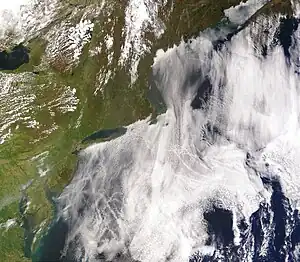
The Twomey effect describes how additional cloud condensation nuclei (CCN), possibly from anthropogenic pollution, may increase the amount of solar radiation reflected by clouds. This is an indirect effect (or radiative forcing) by such particles, as distinguished from direct effects (forcing) due to enhanced scattering or absorbing radiation by such particles not in clouds.
Cloud droplets normally form on aerosol particles that serve as CCN. Increasing the number density of CCN can lead to formation of more cloud droplets with a smaller size.
The increase in number density increases the optical depth of the cloud, which results in an increase in the cloud albedo making clouds appear whiter. Satellite imagery often shows trails of cloud, or of enhanced brightness of cloud, behind ocean-going ships due to this effect. The decrease in global mean absorption of solar radiation due to increases in CCN concentrations exerts a cooling influence on climate; the global average magnitude of this effect over the industrial era is estimated as between −0.3 and −1.8 W/m2.[1]
Derivation
Assume a uniform cloud that extends infinitely in the horizontal plane, also assume that the particle size distribution peaks near an average value of .
The formula for the optical depth of a cloud is
where is the optical depth, is cloud thickness, is the average particle size, and is the number density of cloud droplets.
The formula for the liquid water content of a cloud is
where is the density of water.
Taking our assumptions into account we can combine the previous two equations to yield
To derive the effect of changing while keeping , and constant, from the last equation we can write
and from the equation for we can write
therefore
This illustrates the Twomey Effect mathematically, that is, for a constant liquid water content, , increasing the number density of cloud droplets, , increases the optical depth of the cloud.
See also
References
- ↑ IPCC 4th Assessment Report, 2005
Bibliography
- Hartmann, Dennis L. Global Physical Climatology. Amsterdam: Elsevier, 2016. Print.
- Twomey, S. (December 1974). "Pollution and the planetary albedo". Atmos. Environ. 8 (12): 1251–56. Bibcode:1974AtmEn...8.1251T. doi:10.1016/0004-6981(74)90004-3.
- Twomey, S. (July 1977). "The Influence of Pollution on the Shortwave Albedo of Clouds" (PDF). J. Atmos. Sci. 34 (7): 1149–52. Bibcode:1977JAtS...34.1149T. doi:10.1175/1520-0469(1977)034<1149:TIOPOT>2.0.CO;2.
- Rosenfeld, D. (2006). "Aerosol-Cloud Interactions Control of Earth Radiation and Latent Heat Release Budgets". Space Sci Rev. 125 (1–4): 149–57. Bibcode:2006SSRv..125..149R. doi:10.1007/s11214-006-9053-6. S2CID 122885098.
- Lohmann, U. (2006). "Aerosol Effects on Clouds and Climate" (PDF). Space Sci Rev. 125 (1–4): 129–37. Bibcode:2006SSRv..125..129L. doi:10.1007/s11214-006-9051-8. hdl:20.500.11850/24256. S2CID 121796083.